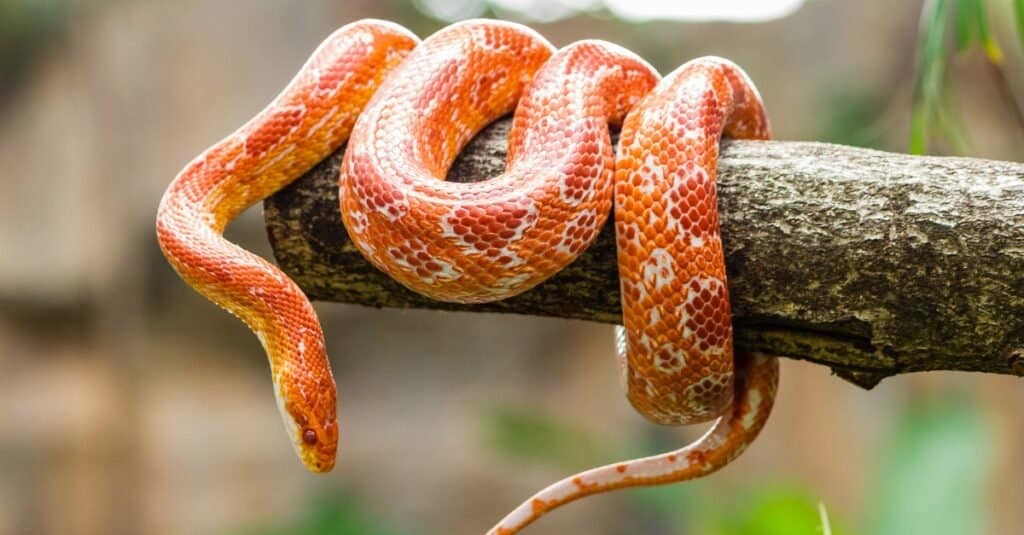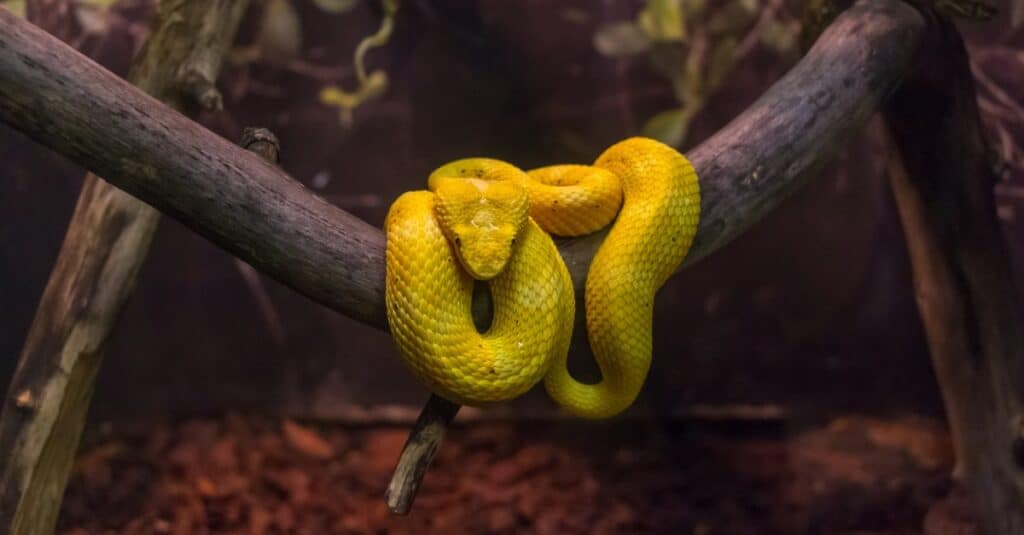It’s not surprising for someone who sees a snake to wonder if snakes have bones. After all, the animal has no limbs and is so flexible it can squeeze prey to death or coil around a tree limb or even its own body. But a snake is a vertebrate with a skeleton, which means it not only has bones, but a backbone to hold them together. Read on to learn more about snakes as we answer the question in more detail: Do snakes have bones?
How Many Bones Does a Snake Have?

©iStock.com/bugphai
Do snakes have bones like mammals? The truth is, snakes only have fewer different types of bones compared to animals such as mammals, but what bones they have are great in number. The number of bones a snake has depends on how big it is. A short-bodied viper such as the puff adder can have about 180 vertebrae in its backbone, while a long-bodied snake such as a mamba can have as many as 400. Most of these vertebrae are attached to a pair of ribs.
But before starting with the backbone of this cold-blooded vertebrate, it’s good to start at the beginning, which of course is the snake’s skull. The problem with being a snake is that one is a carnivore with a very narrow body and no limbs with which to catch and hold on to prey. This would make eating prey difficult even if a snake had the sort of teeth found in the mouths of lions, wolves, or hyenas. So how can a legless reptile, such as a snake, eat?
Snakes have to immobilize their prey some kind of way, so they either squeeze or envenomate their prey, though some snakes just gulp the prey down while it’s still alive. This is where the snake’s flexible skull bones come in. Unlike warm-blooded carnivores, the snake doesn’t have a solid upper jaw. Instead, the upper jaw is made up of separate bones that are held to each other by very stretchy ligaments. These ligaments are so flexible that they can pull the bones up and out. As for the lower jaw, it has two long bones that are attached by stretchable ligaments attached to the back of the skull at the sides. As the upper bones can swing up and out, these bones cab open down and out. This allows the snake to swallow prey two and three times the size of its head.
The snake’s teeth are sharp and point backwards to help push its food down its throat, but they can’t chew. As the teeth grip the prey they work backward and forwards to pull it down the snake’s throat. Since this can take some time, the snake protrudes its windpipe out of its mouth so it can breathe. Snakes also replace their teeth throughout their life.
A vertebrate’s spinal column is made up of vertebrae, and the snake is no exception. In humans, the arrangement of the vertebrae is complex, and in a snake, it’s even more so. The snake’s vertebra is a ball and socket joint that fits into the hollow in the front of the next vertebra. The vertebrae also have bony protuberances called zygapophyses that reach out to touch zygapophyses at the back of the vertebra. Most reptiles have zygapophyses, but the snake also has an extra pair that is found in both the back and the front of each of their vertebra. This means that every vertebra in the snake’s spinal column articulates with the next vertebrae in five places, which makes the joints strong. Interestingly, a single snake joint isn’t flexible in itself, but the great number of them gives the snake its amazing pliability.
Because the snake’s vertebrae haven’t been modified to attach to limbs or a pelvic girdle, they are all pretty much alike. All the vertebrae save the ones in the tail and first or the first and second have ribs. These first two vertebrae make up the atlas, which are attached to the snake’s skull. Some snakes have a vestigial pelvis, but it’s still not attached to any of the vertebrae or ribs.
The snake’s ribs are curved and movable, and the last ribs might have forks. They protect the snake’s viscera, which are long and thin like the reptile. Snake ribs aren’t connected to anything like a sternum the way the ribs of humans are, so they can expand, much like the snake’s jaws, to accommodate large prey. The king cobra is interesting in that it can pull up its front ribs and extend them into a hood as a threat display.
A few snakes are born with what’s left of a pelvis. These include pythons and boas, thread snakes and blind snakes, and snakes in the Anilius genus such as false coral snakes. In pythons, boas, and Anilius snakes the remnant of the pelvis is seen as a pelvic spur on each side of the animal’s cloaca. The bone is covered with something like a horn. The spur tends to be longer in the male, which is how some people can tell male and female snakes apart. The male sometimes uses his spur in courtship and combat.
Why Is Having So Many Bones Useful?
Having a lot of bones helps this reptile be as flexible as it is. A vertebrate with far fewer bones, such as a human, couldn’t possibly bend and twist the way a snake can. The many bones a snake possesses strengthen its spinal column while giving extra protection to its spinal cord.
By the Way, Where Does a Snake’s Tail Begin?

©iStock.com/Maria Khomiakova
Another thing a person might wonder about is where a snake’s tail begins. Can it even be said to have a tail, since its body is just one long tapering tube? But yes, snakes do have proper tails. As the spine gets closer to the end of the animal, the ribs tend to get smaller. There are some snakes where this isn’t the case, such as the rubber boa. The back end of this boa is as big as its front, and when it’s threatened it curls up into a ball, tucks its head in, and sticks its tail out. Predators mistake the tail for a head poised to strike, and even if they bite it off, it’s not a vital part of the snake’s body.
Usually, the snake’s tail is made up of the caudal vertebrae, which are at the very end of the body and don’t have ribs. The tail also has a structure called the haemal arch, which is found on the bottom of the tail. It forms a canal along with the vertebra called a haemal canal, which allows veins and arteries to run through the tail. With a rattlesnake, the last seven or eight vertebrae in the tail are fused, but the rattles themselves aren’t made of bone. They’re made of keratin, the same stuff that makes up fingernails.
Up Next…
Keep reading these posts for more incredible information about key animal facts.
- The Top 10 Biggest Snakes in the World: Some species are so large they feed on deer, others grow to great lengths and are also venomous. Read about these impressive reptiles and many others here.
- What Eats Snakes? 10 Animals That Eat Snakes: Even these fearsome reptiles have their own predators. We introduce you to 10 of them here.
- The 10 Best Pet Snakes: What breeds are tame? Which sort should you give a wide berth? What should you feed your pets? The answers are all provided here.
The photo featured at the top of this post is © DedeDian/Shutterstock.com
Discover the "Monster" Snake 5X Bigger than an Anaconda
Every day A-Z Animals sends out some of the most incredible facts in the world from our free newsletter. Want to discover the 10 most beautiful snakes in the world, a "snake island" where you're never more than 3 feet from danger, or a "monster" snake 5X larger than an anaconda? Then sign up right now and you'll start receiving our daily newsletter absolutely free.
Thank you for reading! Have some feedback for us? Contact the AZ Animals editorial team.






